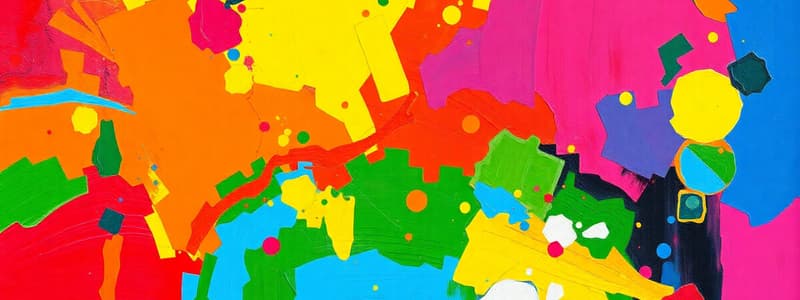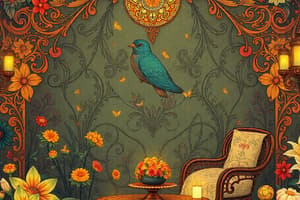Podcast
Questions and Answers
What results from mixing primary colors in additive color mixing?
What results from mixing primary colors in additive color mixing?
- A new primary color
- A darker shade of the original colors
- A neutral color
- The color white (correct)
Which of the following is NOT a primary color in the subtractive color system?
Which of the following is NOT a primary color in the subtractive color system?
- Yellow
- Green (correct)
- Red
- Blue
Tertiary colors are formed by mixing which types of colors?
Tertiary colors are formed by mixing which types of colors?
- A primary color and a secondary color (correct)
- Two primary colors
- Two secondary colors
- A primary color and a neutral color
What is local color primarily associated with?
What is local color primarily associated with?
Which of the following statements about neutral colors is true?
Which of the following statements about neutral colors is true?
What is the effect of adding black and white to a color in terms of values?
What is the effect of adding black and white to a color in terms of values?
Which of the following combinations creates a secondary color in subtractive mixing?
Which of the following combinations creates a secondary color in subtractive mixing?
What is the result of mixing primary colors in equal amounts in subtractive color mixing?
What is the result of mixing primary colors in equal amounts in subtractive color mixing?
What is the result of adding white to a color?
What is the result of adding white to a color?
Which of these colors are examples of analogous colors?
Which of these colors are examples of analogous colors?
What type of color scheme involves colors located directly across from each other on the color wheel?
What type of color scheme involves colors located directly across from each other on the color wheel?
What effect do warm colors have when used in art?
What effect do warm colors have when used in art?
Which statement about complementary colors is true?
Which statement about complementary colors is true?
What is a characteristic of a monochromatic color scheme?
What is a characteristic of a monochromatic color scheme?
In which part of the color wheel are warm colors primarily located?
In which part of the color wheel are warm colors primarily located?
What does the color wheel help artists with besides mixing colors?
What does the color wheel help artists with besides mixing colors?
Flashcards
Tint
Tint
A hue created by adding white to a color.
Shade
Shade
A hue created by adding black to a color.
Color Wheel
Color Wheel
A circular chart organizing visible colors (primary, secondary, and intermediate) by their relationships, helping artists mix and understand pigments.
Monochromatic Color Scheme
Monochromatic Color Scheme
Signup and view all the flashcards
Complementary Colors
Complementary Colors
Signup and view all the flashcards
Analogous Colors
Analogous Colors
Signup and view all the flashcards
Warm Colors
Warm Colors
Signup and view all the flashcards
Cool Colors
Cool Colors
Signup and view all the flashcards
Additive Color Mixing
Additive Color Mixing
Signup and view all the flashcards
Subtractive Color Mixing
Subtractive Color Mixing
Signup and view all the flashcards
Primary Colors
Primary Colors
Signup and view all the flashcards
Secondary Colors
Secondary Colors
Signup and view all the flashcards
Tertiary Colors
Tertiary Colors
Signup and view all the flashcards
Local Color
Local Color
Signup and view all the flashcards
Neutral Colors
Neutral Colors
Signup and view all the flashcards
Color Values
Color Values
Signup and view all the flashcards
Study Notes
Color Theory
- Color is a fundamental element in art, arising from light. Visible light has various color mixtures.
- The visible light spectrum includes Red, Orange, Yellow, Green, Blue, Indigo, and Violet.
- Color can create the illusion of three-dimensional form.
- Two color systems exist: Additive and Subtractive.
Additive Mixing
- Additive mixing describes the mixing of light colors.
- Primary colors in light are Red, Green, and Blue.
- Mixing these in equal amounts produces white light.
- This effect is seen in theater lighting, televisions, and computer monitors.
Subtractive Mixing
- Subtractive mixing explains color mixing using pigments (like paints).
- Primary colors in pigments are Red, Yellow, and Blue.
- Mixing these in equal parts produces black.
- Different color combinations yield other colors.
Primary Colors
- Primary colors are fundamental hues.
- Cannot be made from other colors.
- The primary colors are Red, Blue, and Yellow.
Secondary Colors
- Secondary colors are created by mixing two primary colors.
- Secondary colors are Green, Orange, and Violet (purple).
Tertiary Colors
- Tertiary colors result from mixing a primary and secondary color.
- They are also known as Intermediate colors.
Local Color
- Local color describes object colors as they appear realistically in nature.
- Examples include green grass, blue sky, or brown horses.
Neutral Colors
- Neutral colors include Black, White, Gray and sometimes brown.
- These contain equal parts of primary colors.
Values of Color
- Value refers to the lightness or darkness of a color.
- Value can be adjusted using black and white to create tints and shades.
- Tints are produced by mixing white with a color.
- Shades are produced by mixing black with a color.
Color Wheel
- The color wheel visually represents relationships between colors.
- Colors organized in a circular chart.
- Primary, secondary and intermediate colors are arranged.
Color Schemes
- Color schemes are systematic ways to use the color wheel to combine colors.
- Important color schemes include: Monochromatic, Complementary, Analogous, Warm and Cool.
Studying That Suits You
Use AI to generate personalized quizzes and flashcards to suit your learning preferences.




